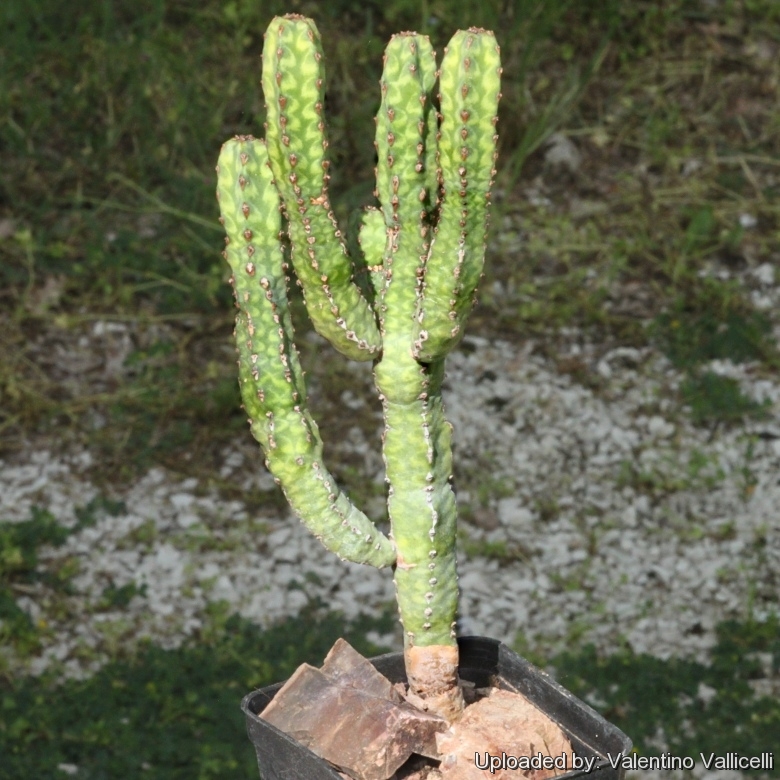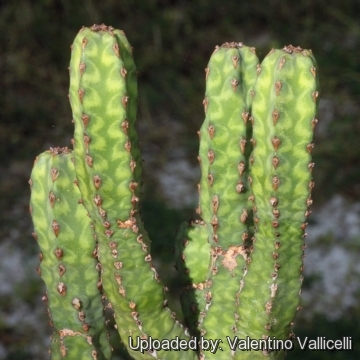= Euphorbia х lyttoniana Dexter
Euphorbia Rev. i. 14 (1935). pro. hybr. Notes: Hort (nom. illeg., Art. 52.1)
Accepted Scientific Name: Euphorbia pseudocactus A.Berger
Sukkul. Euphorb. 78 (1907) A.Berger

Euphorbia pseudocactus subs. lyttoniana (Euphorbia х lyttoniana) Photo by: Valentino Vallicelli
Origin and Habitat: Selected from cultivated material.
Synonyms:
See all synonyms of Euphorbia pseudocactus
back
Accepted name in llifle Database:Euphorbia pseudocactus A.BergerSukkul. Euphorb. 78 (1907)Synonymy: 4
Cultivars
(2):
back
Description: Euphorbia lyttoniana is a very beautiful spineless variant (or cultivar) of Euphorbia pseudocactus with attractively squared stems and a pale green and yellow marbled epidermis and not really qualifying as a columnar Euphorbia. This semi-dwarf, upright mutant was selected from cultivated material and retains its spineless characteristic only by cuttings. E. lyttoniana is slower growing and tends to form closely spaced, compact colonies that can reach nearly 40 cm in height and 70 cm in diameter.
Stem: Thinner, more square in cross-section (not acutely angled) upright, irregular, constricted in twisted, segments about 3-10 cm long, which usually represents a year of growth. These segments are green of varying shades, conspicuously and ornamentally decorated with horizontal or "U" shaped grey-yellow or greenish-yellow markings. The banded variegation seems less pronounced in this variety. On cross section the segments have diameter varying from 1,5 to 2 cm.
Ribs: Usually 4 and hardly armed at all with bark like scales in vertical rows along the ridges.
Leaves: Leaves only appear briefly, less then 2 mm at the very tips of the growing tips only, briefly in summer.
Inflorescences (cymes): 1-3 in an horizontal line from the "flowering eyes", mid-way between each set of spines, simple. Peduncles 2 mm.
Flowers (cyathia): Up to 7 mm across. Nectar glands oblong, yellow and touching.
Fruits (capsules): Subsessile, acutely lobed, to 14 mm across.
Seeds: Subglobose, 3 mm in diameter smooth.
Bloom Season: Late winter through Late Summer.
Subspecies, varieties, forms and cultivars of plants belonging to the Euphorbia pseudocactus group
 Euphorbia х lyttoniana Dexter: It is a spineless variant with intense markings usually shorter, it is also more square in cross-section, forming very compact, dense colonies of upright columns, selected from cultivated material.
Euphorbia х lyttoniana Dexter: It is a spineless variant with intense markings usually shorter, it is also more square in cross-section, forming very compact, dense colonies of upright columns, selected from cultivated material. Euphorbia pseudocactus A.Berger: Multi-branched, dwarf-stemmed, candelabra shaped succulent, 60-120 cm tall. The stems often have distinctive yellow V-shaped markings. Plants eventually form large mounded clumps.
Euphorbia pseudocactus A.Berger: Multi-branched, dwarf-stemmed, candelabra shaped succulent, 60-120 cm tall. The stems often have distinctive yellow V-shaped markings. Plants eventually form large mounded clumps. Euphorbia pseudocactus f. cristata hort.: crested form.
Euphorbia pseudocactus f. cristata hort.: crested form.- Euphorbia pseudocactus cv. Miniature: (a.k.a. "dwarf form" )Seedlings of the miniature form sometimes appears among normal seedlings of this species. Their branches are (3-) 4- to 5-angled, little segemented and only 2 to 2.5 cm in diameter.
- Euphorbia pseudocactus cv. Zig Zag: (sometimes called a Zig-Zag plant): far more popular, it is similar in form to Euphorbia grandicornis, but a much smaller and more manageable size.
Bibliography: Major references and further lectures
1) Urs Eggli “Illustrated Handbook of Succulent Plants: Dicotyledons” Volume 2. Springer, 2002
2) Doreen Court “Succulent Flora of Southern Africa” CRC Press, 01/giu/2000
3) Gideon Smith, Neil R. Crouch “Guide to Succulents of Southern Africa” Struik Nature, 01/nov/2009
4) James Cullen, Sabina G. Knees, H. Suzanne Cubey “The European Garden Flora Flowering Plants: A Manual for the Identification of Plants Cultivated in Europe, Both Out-of-Doors and Under Glass” Cambridge University Press, 11/ago/2011
5) White, A., Dyer, R.A. & Sloane, B.L. 1941.”The succulent Euphorbieae, vol. 2.“ Abby Garden Press. Pasadena, California.
6) Hermann Jacobsen “A handbook of succulent plants: descriptions, synonyms, and cultural details for succulents other than Cactaceae” Volume 1 Blandford Press, 1960
7) Hermann Jacobsen “Abromeitiella to Euphorbia” Blandford Press, 1960
8) The Euphorbia Journal-Strawberry Press-Vol.1 Page 106/Vol 5 Page 144.
 Euphorbia pseudocactus subs. lyttoniana (Euphorbia х lyttoniana) Photo by: Valentino Vallicelli
Euphorbia pseudocactus subs. lyttoniana (Euphorbia х lyttoniana) Photo by: Valentino Vallicelli Euphorbia pseudocactus subs. lyttoniana (Euphorbia х lyttoniana) Photo by: Valentino Vallicelli
Euphorbia pseudocactus subs. lyttoniana (Euphorbia х lyttoniana) Photo by: Valentino VallicelliCultivation and Propagation: Euphorbia x lyttoniana is an easy species to grow that is suited for any well drained soil in full sun. But young plant are happy growing indoors.
Growth rate: The lyttoniana is a slow growing cultivars.
Soil: Give the plant an airy growing medium which mainly consists of non organic material such us clay, pumice, lava grit, and only a little peat or leaf-mould.
Repotting: It Like quite small pots, repott in very later winter, early spring.
watering: Water regularly during the active growing season from March to September. No water should ever be allowed to stand around the roots. Keep almost completely dry in winter. If plant becomes very red, this is a sign that the roots have not developed properly.
Exposure: It can tolerate moderate shade, and a plant that has been growing in shade should be slowly hardened off before placing it in full sun as the plant will be severely scorched if moved too suddenly from shade into sun.
Maintenance: Plants can be pruned for shape and branching.
Hardiness: Frost tender, frost free zones only.
Plant Pests: Prone to mealy bugs and rarely scale.
Propagation: It is easy to propagate by cuttings in late spring to summer, just take a cutting of the plant let it dry for 1 or 2 weeks and stuff it in the ground (preferably dry, loose, extremely well draining soil).
Warning: All Euphorbias contain a white sap that can be irritating to eyes and mucous membranes. If contact is made with this white sap, take care to not touch face or eyes before washing hands with soap and water.












